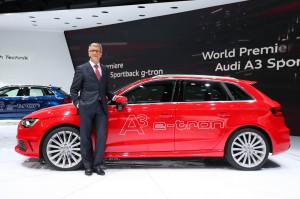Audi debuted its A3 Sportback e-tron at the Geneva Motor Show on Tuesday, a plug-in hybrid that, in pure electric mode, reaches a top speed of 81 mph and a range of up to 31 miles.
The car uses what’s called a parallel hybrid, which, like many other EVs on the market, pairs a combustion engine with an electric motor powered by a lithium ion battery. It can be driven with just the combustion engine, just the electric motor, or in hybrid mode. To further its efficiency, the A3 e-tron uses regenerative braking, which takes the energy used in braking and channels it back into the battery — a technology that’s also used in cars from the 2013 Ford Fusion Energi debuted at January’s Detroit Auto Show to the Land Rover Electric Defender, also showing this week in Geneva.

Audi CEO Rupert Stadler next to the Audi A3 Sportback e-tron at the 2013 Geneva Motorshow
When Audi sources said last month that the German carmaker was not planning to bring the A2 pure electric and plug-in hybrid concepts to production, it unleashed lots of speculation about how invested the company was in electric vehicles. Unveiled at the 2011 Frankfurt Auto Show, the A2 was originally positioned to compete with the BMW i3 and the Mercedes-Benz A-Class and now joins the A1 e-tron in the concept car limbo.
Amid reports that this move came as a result of pricing concerns, as well as industry and consumer trending away from EV, Audi Corporate Communications Manager Brad Stertz insisted that the company remains invested in producing green vehicles.
“We’re taking a holistic approach that puts some of the concepts mentioned through rigorous examination,” Stertz said. “The end result will be to have an Audi EV that drives like the luxury performance car that’s expected of Audi.”
Though the future of some Audi’s electric concepts are uncertain, Stertz says that this is not reflective of low confidence in EV. It is simply part of the process while the company’s engineers work toward packages that are consistent with the brand– and, in referring to the A3 e-tron as its “realistic glimpse into the future of mobility”, it seems this particular EV may have legs. In the meantime, Audi is continuing to develop other green energy alternatives. Though the Audi plug-in technology has yet to stray too far from the path already taken by its competitors, the German carmaker may be making innovative strides in another area – the use of alternative fuels.
Also debuting this week in Geneva is the natural gas-powered 2014 A3 g-tron, which is set to hit showrooms later this year. Natural gas powered luxury vehicles are rare, and even more unusual is the role Audi is taking in powering them. Rather than just install a natural gas-capable engine, Audi plans to generate its own synthetic natural gas for customers by building a plant that will use solar and wind power to create methane. While the efficiency of this process is questionable and the infrastructure for widely distributing this gas is not yet in place, Audi’s willingness to get into the natural gas game is certainly inventive.

The new A3 Sportback g-tron is powered by the CO2-neutral Audi e-gas